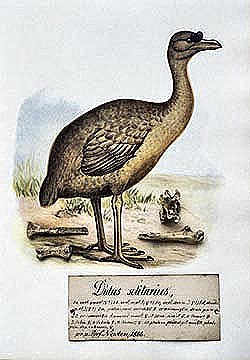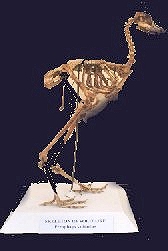The
Rodriguez Solitaire is known from a large number of bones found on the
island of Rodriguez in the Indian Ocean. No mounted specimens of the
Rodriguez Solitaire exist.
Most
of our knowledge of its appearance and behaviour is derived from the
account of the French Huguenot François Leguet, who was marooned on the
island between 1691 and 1693.
Amongst
other peculiarities, Leguat described the birds' odd nesting behaviour.
For example, a pair would not allow any other Rodriguez Solitaire near the
nest. If intruders did appear, males would drive off rival males, while
females dealt with females. Whenever a male was confronted with a female
intruder it called its partner to chase the stranger off.
The
Huguenots also praised the birds for their flavour. The young, who were
caught in the summer, were considered a particular delicacy. They were
easy to catch, due to their inability to fly.
Leguat's
account was written around 1690. From an anonymous author we know the
Rodriguez Solitaire was still quite common in 1730. The birds were heavily
hunted by humans and predated by introduced cats. The Rodriguez Solitaire
was very rare by 1755, when Cossigny tried to obtain one without success,
but was told that the species did still survive. When a French research
vessel visited the island in 1761, it also did not find any Rodriguez
Solitaires, even though inhabitants claimed that some were still here. If
the species still survived in 1761, it probably became extinct shortly
after.
The
closest relatives of the Rodriguez Solitaire are the Dodo (Raphus cucullatus) and the Réunion Solitaire (Raphus
solitarius).
|
|
|
|
|
|

